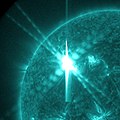Fail:X Class Solar Flare Sends ‘Shockwaves’ on The Sun (6819094556).jpg

Algfail (2104 × 2108 pikslit, faili suurus: 1,2 MB, MIME tüüp: image/jpeg)
| See fail ja sellest kastist allapoole jääv kirjeldus pärinevad kesksest failivaramust Wikimedia Commons. | Faili lehekülg Commonsis |
Lühikirjeldus
| KirjeldusX Class Solar Flare Sends ‘Shockwaves’ on The Sun (6819094556).jpg |
NASA image captured March 6, 2012 To view a video of this event go to: www.flickr.com/photos/gsfc/6815861366 The sun erupted with one of the largest solar flares of this solar cycle on March 6, 2012 at 7PM ET. This flare was categorized as an X5.4, making it the second largest flare -- after an X6.9 on August 9, 2011 -- since the sun’s activity segued into a period of relatively low activity called solar minimum in early 2007. The current increase in the number of X-class flares is part of the sun’s normal 11-year solar cycle, during which activity on the sun ramps up to solar maximum, which is expected to peak in late 2013. About an hour later, at 8:14 PM ET, March 6, the same region let loose an X1.3 class flare. An X1 is 5 times smaller than an X5 flare. These X-class flares erupted from an active region named AR 1429 that rotated into view on March 2. Prior to this, the region had already produced numerous M-class and one X-class flare. The region continues to rotate across the front of the sun, so the March 6 flare was more Earthward facing than the previous ones. It triggered a temporary radio blackout on the sunlit side of Earth that interfered with radio navigation and short wave radio. In association with these flares, the sun also expelled two significant coronal mass ejections (CMEs), which are travelling faster than 600 miles a second and may arrive at Earth in the next few days. In the meantime, the CME associated with the X-class flare from March 4 has dumped solar particles and magnetic fields into Earth’s atmosphere and distorted Earth's magnetic fields, causing a moderate geomagnetic storm, rated a G2 on a scale from G1 to G5. Such storms happen when the magnetic fields around Earth rapidly change strength and shape. A moderate storm usually causes aurora and may interfere with high frequency radio transmission near the poles. This storm is already dwindling, but the Earth may experience another enhancement if the most recent CMEs are directed toward and impact Earth. In addition, last night’s flares have sent solar particles into Earth’s atmosphere, producing a moderate solar energetic particle event, also called a solar radiation storm. These particles have been detected by NASA’s SOHO and STEREO spacecraft, and NOAA’s GOES spacecraft. At the time of writing, this storm is rated an S3 on a scale that goes up to S5. Such storms can interfere with high frequency radio communication. Besides the August 2011 X-class flare, the last time the sun sent out flares of this magnitude was in 2006. There was an X6.5 on December 6, 2006 and an X9.0 on December 5, 2006. Like the most recent events, those two flares erupted from the same region on the sun, which is a common occurrence. Credit: NASA/SDO/AIA NASA Goddard Space Flight Center enables NASA’s mission through four scientific endeavors: Earth Science, Heliophysics, Solar System Exploration, and Astrophysics. Goddard plays a leading role in NASA’s accomplishments by contributing compelling scientific knowledge to advance the Agency’s mission. Follow us on Twitter Like us on Facebook Find us on Instagram |
| Kuupäev | |
| Allikas | X Class Solar Flare Sends ‘Shockwaves’ on The Sun |
| Autor | NASA Goddard Space Flight Center from Greenbelt, MD, USA |
Litsents
- Tohid:
- jagada – teost kopeerida, levitada ja edastada
- kohandada – valmistada muudetud teoseid
- Järgmistel tingimustel:
- omistamine – Pead materjali sobival viisil autorile omistama, tooma ära litsentsi lingi ja märkima ära, kas on tehtud muudatusi. Sobib, kui teed seda mõistlikul viisil, kuid seejuures ei tohi jääda muljet, et litsentsiandja tõstab esile sind või seda, et sina materjali kasutad.
| NASA Goddard Photo and Video postitas selle pildi algselt saidile Flickr. Robot FlickreviewR vaatas selle pildi üle ja kinnitas, et see oli saadaval litsentsi cc-by-2.0 all. Vaadatud: 17. september 2016 |
17. september 2016
| Public domainPublic domainfalsefalse |
| See fail on avalikus omandis, sest selle autori NASA autoriõiguspõhimõtte järgi ei ole ilma vastava märketa NASA materjalid autoriõigusega kaitstud. (NASA autoriõiguspõhimõtted või JPL-i piltide kasutuspõhimõtted). |  | |
 |
Hoiatused:
|
Pealdised
Selles failis kujutatud üksused
kujutab
Teatud väärtus ilma Vikiandmete üksuseta
7. märts 2012
media type inglise
image/jpeg
Faili ajalugu
Klõpsa kuupäeva ja kellaaega, et näha sel ajahetkel kasutusel olnud failiversiooni.
| Kuupäev/kellaaeg | Pisipilt | Mõõtmed | Kasutaja | Kommentaar | |
|---|---|---|---|---|---|
| viimane | 18. september 2016, kell 00:48 |  | 2104 × 2108 (1,2 MB) | Vanished Account Byeznhpyxeuztibuo | Transferred from Flickr via Flickr2Commons |
Faili kasutus
Seda faili kasutab järgmine lehekülg:
Globaalne failikasutus
Järgmised muud vikid kasutavad seda faili:
- Faili kasutus vikis bn.wikipedia.org
- Faili kasutus vikis en.wikipedia.org
Metaandmed
See fail sisaldab lisateavet, mille on tõenäoliselt lisanud digikaamera või skanner.
Kui faili on rakendustarkvaraga töödeldud, võib osa andmeid olla muudetud või täielikult eemaldatud.
| Pildi pealkiri |
|
|---|---|
| Pealkiri | X Class Solar Flare Sends ‘Shockwaves’ on The Sun |
| Pikslite koosseis | Palett |
| Orientatsioon | Normaalne |
| Horisontaalne eraldus | 100 dpi |
| Vertikaalne eraldus | 100 dpi |
| Kasutatud tarkvara | IDL 7.0, ITT Visual Information Solutions |
| Faili muutmise kuupäev ja kellaaeg | 7. märts 2012, kell 09:27 |
| Pakilisus | Kõrge (2) |
| IIM-i versioon | 4 |
